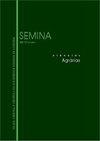直播细粒稻(Oryza sativa)中细粒稻(Leptochloa chinensis)经济阈值的估算
IF 0.5
4区 农林科学
Q4 AGRICULTURE, MULTIDISCIPLINARY
引用次数: 0
摘要
:中国细藻(Leptochloa chinensis)沙草是一种杂草,正在成为旱地和低地水稻的严重威胁。2018年和2019年夏季,在巴基斯坦旁遮普省萨戈达大学农学研究农场进行了一项实地研究,以评估羊草密度对直播优质水稻产量的影响。试验采用随机完全区组设计,每个处理4个重复,处理密度分别为0、5、10、15、20和25株m-2。结果表明,羊草的存在显著阻碍了直播水稻的产量。2018年和2019年,25个羊草m-2植株的杂草侵染分别造成63%和69%的产量损失。产量下降主要是由于2018年和2019年千粒重减少22.9%和29.1%,分蘖数减少65.8和60.0%,穗数减少53.3和60%。杂草侵染最高(25株m-2),在2018年和2019年产生了最高的杂草干生物量(687和669 g m-2)、氮吸收量(19.3和19.3 kg ha-1)、磷吸收量(1.92和2.32 kg ha-1)和钾吸收量(20.53和20.27 kg ha-1)。2018年和2019年,杂草侵染最少(5株m-2)的杂草干生物量(47和85 g m-2)、氮吸收量(1.6和2.9)、磷吸收量(0.3和0.5)和钾吸收量(1.7和30 kg hm -1)最小。2018年和2019年羊草造成6.73%和6.08%产量损失的经济阈值分别为1.70和1.73株m-2。综上所述,羊草是水稻直播稻中的一种严重杂草,应在其密度达到1.70 ~ 1.73株m-2时进行控制,以免造成显著的产量损失。本文章由计算机程序翻译,如有差异,请以英文原文为准。
Estimation of the economic threshold of Leptochloa chinensis (Chinese sprangletop) in direct-seeded fine grain rice (Oryza sativa)
: Leptochloa chinensis (L.) Nees (Chinese sprangletop) is a weed that is becoming a serious threat in upland and lowland rice. A field study was conducted at the Agronomic Research Farm, University of Sargodha, Punjab, Pakistan, during the summer seasons of 2018 and 2019 to evaluate the effect of L. chinensis density on the yield of direct-seeded fine rice. Treatments comprised of L. chinensis densities of 0, 5, 10, 15, 20 and 25 plants m-2, and the experiment was laid out in a randomized complete block design with four replications of each treatment. The results suggest that the presence of L. chinensis significantly hampered the grain yield of direct-seeded rice. Weed infestation caused 63% and 69% yield losses where 25 L. chinensis plants m-2 were sustained in 2018 and 2019, respectively. Yield reduction was due to the reduction in 1000-grain weight (22.9 and 29.1%), number of tillers m-2 (65.8 and 60.0%), and number of grains panicle-1 (53.3 and 60%) in 2018 and 2019, respectively. The highest weed infestation (25 plants m-2) produced the highest weed dry biomass (687 and 669 g m-2), N uptake (19.3 and 19.3 kg ha-1), P uptake (1.92 and 2.32 kg ha-1), and K uptake (20.53 and 20.27 kg ha-1) in 2018 and 2019, respectively. The lowest weed infestation (5 plants m-2) produced minimum weed dry biomass (47 and 85 g m-2), N uptake (1.6 and 2.9), P uptake (0.3 and 0.5), and K uptake (1.7 and 30 kg ha-1) in 2018 and 2019, respectively. The economic threshold of L. chinensis as estimated to cause 6.73% and 6.08% yield loss by the prediction model was 1.70 and 1.73 plants m-2 during 2018 and 2019, respectively. It can be concluded that L. chinensis is a serious weed in direct-seeded rice and it should be controlled when its density reaches 1.70-1.73 plants m-2 to avoid significant yield losses.
求助全文
通过发布文献求助,成功后即可免费获取论文全文。
去求助
来源期刊

Semina-ciencias Agrarias
农林科学-农业综合
CiteScore
1.10
自引率
0.00%
发文量
148
审稿时长
3-6 weeks
期刊介绍:
The Journal Semina Ciencias Agrarias (Semina: Cien. Agrar.) is a quarterly publication promoting Science and Technology and is associated with the State University of Londrina. It publishes original and review articles, as well as case reports and communications in the field of Agricultural Sciences, Animal Sciences, Food Sciences and Veterinary Medicine.
 求助内容:
求助内容: 应助结果提醒方式:
应助结果提醒方式:


